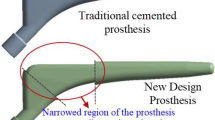Summary
There are two methods for the fixation of prostheses to bone; one is a method using bone cement and another is the direct fixation of the prostheses to bone. Four types of animal experiments were performed to compare the two methods of fixation. A small pyramid shaped test piece was used to compare the fixation capacity of the socket spike. Also, a special test piece was used to study the time of bone formation, to check the fixation capacity of bone bar formation occurring in the hole in the based part of the prosthetic component. Furthermore, models of prosthetic stem and socket were made and attached to the femur and ilium of dog to perform fixation tests and fatigue tests. As a result, any of the tests proved that the direct fixation method without the usage of bone cement was superior to the fixation method using bone cement.
Zusammenfassung
Vier tierexperimentelle Anordnungen wurden ausgeführt, um die Prothesenverankerung im Knochen mit und ohne Zement zu vergleichen. Verschiedene Prüfkörper wurden benutzt, um die Festigkeit der Verankerung und den Ablauf der Knochenanlagerung zu untersuchen. Außerdem wurden Modelle von Prothesenschäften und Prothesenpfannen für Verankerungs- and Ermüdungsuntersuchungen verwendet. Alle these experimentellen Untersuchungen haben ergeben, daß die direkte, zementfreie Verankerung der Implantate jener mit Knochenzement überlegen ist.
Similar content being viewed by others
References
Iida K (1973) New improved bone cement (MMA-TBB). Rinshoseikei 8:109–117
Itami Y (1976) Preliminary report of our total hip prosthesis. Z Orthop 114:719–721
Jäger M (1974) Experimentelle Forsionslockerung technisch verschieden implantierter Hüftendoprothesenpfannen. Z Orthop 112:34–44
Kölbel R (1974) Mechanische Eigenschaften einer Verbindung von spongiösen Knochen und Polymethylmethacrylat bei periodischer Belastung. Arch Orthop Unfall Chir 80:31–43
Kratzert R, Schellmann W-D (1970) Verankerungsprobleme bei der Anwendung autopolymerisierender Kunststoffimplantate. Arch Orthop Unfall Chir 68:351–357
Lembert E (1972) Fixation of skeletal replacement by fiber metal composites. Clin Orthop 87:303–310
Nagai M (1978) Experimental study on total hip prosthesis. J Jap Orthop Ass 52:1607–1623
Paul JP (1976) Loading on normal hip and knee joints and on joint replacements, artificial hip and knee joint technology. Springer, New York, pp 53–70
Tomita Y (1974) Experimental study on total hip prosthesis. J Jap Orthop Ass 48:337–351
Author information
Authors and Affiliations
Rights and permissions
About this article
Cite this article
Itami, Y., Akamatsu, N., Tomita, Y. et al. The direct fixation system of total hip prosthesis. Arch. Orth. Traum. Surg. 100, 11–17 (1982). https://doi.org/10.1007/BF00381537
Received:
Issue Date:
DOI: https://doi.org/10.1007/BF00381537




